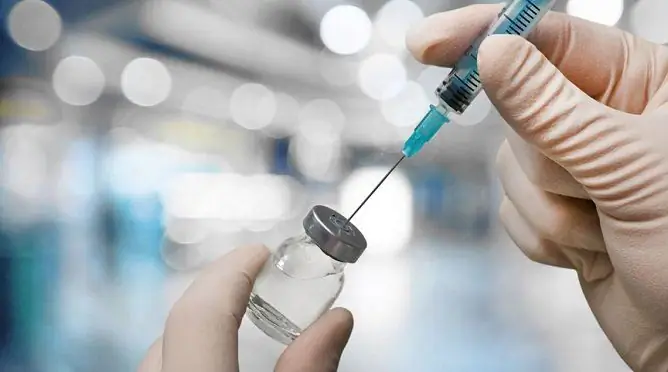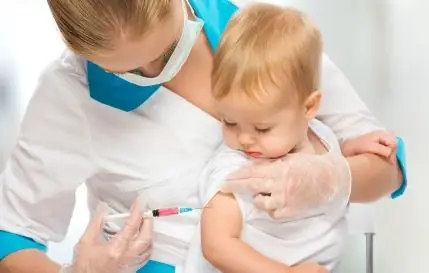- Author Rachel Wainwright [email protected].
- Public 2023-12-15 07:39.
- Last modified 2025-11-02 20:14.
Varilrix
Varilrix: instructions for use and reviews
- 1. Release form and composition
- 2. Pharmacological properties
- 3. Indications for use
- 4. Contraindications
- 5. Method of application and dosage
- 6. Side effects
- 7. Overdose
- 8. Special instructions
- 9. Application during pregnancy and lactation
- 10. Drug interactions
- 11. Analogs
- 12. Terms and conditions of storage
- 13. Terms of dispensing from pharmacies
- 14. Reviews
- 15. Price in pharmacies
Latin name: Varilrix
ATX code: J07BK01
Active ingredient: live attenuated virus Varicella Zoster (Oka strain) [vivere attenuated virus Varicella Zoster (contentionem Oka)]
Producer: GlaxoSmithKline Biologicals, sa (Belgium)
Description and photo updated: 15.08.2018
Prices in pharmacies: from 1950 rubles.
Buy

Varilrix is a vaccine for the prevention of chickenpox.
Release form and composition
Varilrix dosage form is a lyophilisate for the preparation of a solution for subcutaneous (s / c) administration: amorphous mass (powder) from light yellow to creamy yellow color (0.5 ml (1 dose) in a 3 ml glass bottle, in a polyethylene blister 1 bottle complete with solvent (1 ampoule or 1 syringe, or 1 syringe with 1 or 2 needles), in a cardboard box 1 blister).
0.5 ml of the vaccine contains:
- active substance: Varicella zoster (Oka strain), a live attenuated virus with specific activity, obtained by propagation of MRC-5 human diploid cells in culture - not less than 3.3 lg PFU (plaque-forming units);
- excipients: lactose, neomycin sulfate, human serum albumin, mannitol, amino acids, sorbitol.
Solvent: water for injection.
Pharmacological properties
Varilrix is characterized by an immunostimulating effect.
Pharmacodynamics
As indicated in the instructions, Varilrix is a live attenuated vaccine designed to prevent chickenpox. It contains the live attenuated Varicella Zoster virus (Oka strain), which is cultured in MRC-5 human diploid cells. Varilrix meets all the requirements of the World Health Organization for the production of medical immunobiological preparations.
After administration, Varilrix stimulates the production of antibodies to the varicella-zoster virus, which makes it possible to form a specific body defense against this infectious disease. A certain degree of protection is achieved in cases where immunization was carried out within 3 days after a person's contact with the Varicella Zoster virus. It is believed that an antibody titer equal to or greater than 1/4 and determined by the method of indirect immunofluorescence reaction (NRIF) has protective properties.
Almost all healthy children, whose age ranged from 9 months to 12 years, inclusive, 6 weeks after vaccination, had a fairly high level of protection, which remained at least 7 years after the introduction of Varilrix. The introduction of even 1 dose of the vaccine can effectively prevent 81% of all hospitalizations of pediatric patients due to this disease, and 87% of outpatient visits to the doctor. However, in children who received 1 dose of Varilrix, there were isolated cases of the disease provoked by the wild strain of Varicella Zoster, in periods exceeding 42 days after vaccination.
In all children over 13 years of age, after two doses of vaccination, a pronounced level of protection was registered, lasting at least 1 year (during monitoring in the framework of a clinical study). Clinical studies have confirmed that most of the vaccinated who subsequently came into contact with patients with chickenpox are either not susceptible to this disease, or they suffer it in a much milder form (there is no fever, the number of rashes is significantly less).
In patients belonging to high-risk groups, it is necessary to periodically determine the titers of antibodies to the varicella-zoster virus, which allows a timely decision on the need for additional vaccination.
Categories of patients for whom chickenpox is a significant risk factor contributing to a worsening of the course and prognosis of an existing severe disease:
- healthy people who have come into direct contact with people with chickenpox or high-risk groups, who have not been sick with this disease and have not been vaccinated before;
- patients with acute leukemia;
- patients suffering from severe chronic diseases (neuromuscular disorders, endocrine and metabolic disorders, cystic fibrosis, chronic diseases of the cardiovascular system and lungs);
- patients who should soon undergo a transplant operation.
Patients from the above groups who are undergoing immunosuppressive therapy (including taking corticosteroids) in connection with the treatment of large malignant tumors or severe chronic diseases (severe bronchial asthma, renal failure, systemic connective tissue diseases, autoimmune diseases) are considered susceptible to chickenpox disease. smallpox in severe form.
In high-risk patients, the seroconversion rate reaches 80%, and in patients with leukemia, approximately 90%. One study found that the incidence of chickenpox in patients with leukemia was lower in vaccinated patients than in patients who did not receive the vaccine and were naturally infected. Transmission of the virus contained in Varilrix has also been reported between sisters and brothers with immunodeficiency, but skin rashes were mild in infected children.
Pharmacokinetics
The pharmacokinetics of Varilrix have not been studied in detail at the moment.
Indications for use
- prevention of chickenpox in persons from 1 year of age belonging to the high-risk group, previously not vaccinated and not sick with chickenpox;
- urgent prophylaxis of chickenpox in those who have not had chickenpox and who have not previously been vaccinated after close contact with patients with chickenpox (including family members of the patient, doctors, medical personnel, and others).
Contraindications
- acquired or primary immunodeficiency (the number of lymphocytes is less than 1200 / μl), which developed as a result of blood dyscrasia, leukemia, lymphoma, clinical manifestations of HIV infection, taking immunosuppressants (including high-dose corticosteroid therapy), which was diagnosed for several signs of cellular immunodeficiency;
- diseases of infectious and non-infectious genesis in acute form and exacerbation of chronic pathologies (refer to temporary contraindications for vaccinations);
- an increase in body temperature in acute intestinal diseases and mild acute respiratory viral infections (ARVI) - vaccination with Varilrix can be carried out only after the temperature has returned to normal;
- planned conception within the next 3 months;
- the period of pregnancy and breastfeeding;
- individual intolerance to the components of the vaccine or symptoms of hypersensitivity to the previous administration of the Varilrix vaccine.
Instructions for the use of Varilrix: method and dosage
The ready-made solution of the Varilrix vaccine is intended for s / c administration.
The solution for injection is prepared before direct use by dissolving the contents of the vial with a solvent. To do this, by opening the vial with the vaccine, a solvent is injected into it using a syringe (the resulting suspension should be shaken well, about 3 minutes) and after the lyophilisate is completely dissolved, the drug is taken into the syringe. The finished solution should be from pink to yellow-pink in color and have a transparent (without visible inclusions and sediment) structure. In case of visual detection of any deviations from the norm, the vaccine must be disposed of.
After treating the injection site with a disinfectant (including alcohol), you should wait for it to evaporate in order to prevent possible inactivation of the vaccine virus upon contact.
Intravenous administration of Varilrix is contraindicated, and intradermal injections should also be avoided.
Vaccination is carried out according to the scheme:
- children from 1 to 13 years old: once - 1 dose of the vaccine (0.5 ml);
- persons over 13 years of age and in contact with sick or high-risk groups: twice - 1 dose on the day of vaccination and on the day of revaccination (after a break of 42-70 days).
Vaccination of patients with acute leukemia, severe chronic diseases or those undergoing radiation therapy and immunosuppressive therapy should be carried out in a state of complete hematological remission of the underlying disease. In addition, it is necessary to make sure that there are no symptoms indicating a lack of cellular immunity, and that the total number of lymphocytes is not less than 1200 / μl.
When planning vaccination in the acute phase of leukemia, the patient's chemotherapy should be interrupted for 14 days (7 days before and 7 days after vaccination).
During the period of radiation therapy, vaccination should not be carried out.
In case of elective organ transplant surgery, vaccinations should be given several weeks before starting immunosuppressive drugs.
Vaccination for the purpose of emergency prevention is carried out by a single injection of 1 dose of Varilrix during the first 3-4 days after contact with patients.
Side effects
Adverse reactions registered within 42 days after vaccination of 5369 persons, including children, adolescents and adults:
- from the central nervous system: sometimes - drowsiness, headache;
- from the respiratory system: sometimes - cough, rhinitis, pharyngitis, infectious pathologies of the upper respiratory tract;
- on the part of the organ of vision: rarely - conjunctivitis;
- from the digestive system: sometimes - vomiting, diarrhea; rarely - abdominal pain;
- from the musculoskeletal system: sometimes - myalgia, arthralgia;
- dermatological reactions: often - rash; sometimes - pruritis and skin rashes, similar to a rash with chickenpox; rarely - urticaria;
- on the part of the body as a whole: often - an increase in temperature (rectal - 38 ° C and higher, when measured in the armpit or oral cavity - 37.5 ° C and higher); sometimes - malaise, lymphadenopathy, weakness, fever: rectal - 39.5 ° C and above, when measured in the armpit or oral cavity - 39 ° C and above;
- local reactions: very often - redness and pain at the injection site; often - edema of the injection site.
In addition, against the background of the massive use of the vaccine, adverse effects are reported, which are attributed to temporarily associated symptoms or symptoms not necessarily associated with vaccination:
- from the central nervous system: ataxia, convulsions;
- allergic reactions: possibly - anaphylactoid and anaphylactic reactions;
- others: possibly - infections caused by the Varicella zoster virus, hypersensitivity reactions.
In high-risk patients, vaccination can cause mild reactions at the injection site, papular vesicular rash (in rare cases, with mild to moderate fever).
Overdose
There are isolated reports of unintentional overdose of Varilrix. In some of them, the presence of unwanted symptoms such as convulsions and lethargy is noted. In other cases, an overdose did not provoke the development of body reactions that threaten life or health.
special instructions
The introduction of Varilrix should be carried out only if funds are available to stop the anaphylactic reaction. After immunization, the patient's condition should be monitored for 0.5 hour.
For people of childbearing age, reliable contraceptive methods are required for three months after vaccination.
In the presence of primary or acquired immunodeficiency, vaccination should be carried out only after preliminary determination of the number of lymphocytes.
After vaccination against the background of massive therapy with immunosuppressants, the development of chickenpox with clinical signs is possible.
The medical staff should inform the patient about the existing risk of transmission of the vaccine virus and the need to observe precautions when dealing with pregnant women who are especially sensitive to chickenpox in the first trimester of gestation, with leukemia patients or receiving immunosuppressive therapy. If rashes are detected within three weeks after vaccination, the patient should completely exclude contacts with pregnant women (especially in the first trimester) and persons with immunodeficiency states.
The influence of Varilrix on the ability to drive vehicles and mechanisms is unlikely.
Application during pregnancy and lactation
There are no data on the effect of Varilrix on fertility. During pregnancy, vaccination with the drug is prohibited. It is not recommended to allow pregnancy to occur within 1 month after vaccination. It is preferable for patients planning a pregnancy to postpone the onset of pregnancy for at least this period of time.
There is no relevant information on vaccinations of Varilrix in humans during pregnancy, and experiments to determine reproductive toxicity in animals have not been carried out.
The use of the vaccine is contraindicated during breastfeeding.
Drug interactions
After blood transfusion or the use of immunoglobulins, the introduction of Varilrix is possible only after 3 months.
After vaccination, salicylates should not be used for 1.5 months, since there is a risk of Reye's syndrome developing against the background of a viral infection.
Varilrix does not reduce the immune response and does not increase its reactogenicity during simultaneous vaccination against measles-rubella-mumps or against diphtheria-tetanus-pertussis. Vaccinations are carried out in different parts of the body and with separate syringes.
If measles-rubella-mumps vaccines or diphtheria-tetanus-pertussis vaccines were not prescribed simultaneously with the varicella-zoster vaccine, then an interval of at least 1 month is required between the use of these or other vaccines to achieve the maximum antibody level.
The simultaneous administration of the drug with attenuated live vaccines is contraindicated in high-risk individuals.
Analogs
The analogue of Varilrix is Okavax (lyophilisate).
Terms and conditions of storage
Keep out of the reach of children.
Store at a temperature: vaccine - 2-8 ° C, including during transportation, do not freeze; solvent - 2-25 ° C.
Shelf life: vaccine - 2 years, diluent - 5 years.
Terms of dispensing from pharmacies
Dispensed by prescription.
Reviews about Varilrix
On the Internet, there are mainly positive reviews about Varilrix, which are mainly left by parents. They note a low incidence of adverse reactions and a good tolerance of the vaccine: children had a slight increase in temperature, a slight runny nose and a minimal number of skin rashes. It was reported that the general well-being with such symptoms did not worsen. However, there are reports that vaccinated children get sick in almost the same way as unvaccinated ones, on the basis of which parents conclude that it is better to get sick with chickenpox on their own, without using Varilrix.
Price for Varilrix in pharmacies
The approximate price for Varilrix in pharmacy chains varies from 1350 to 3320 rubles per dose.
Varilrix: prices in online pharmacies
|
Drug name Price Pharmacy |
|
Varilrix lyophilisate for the preparation of a suspension for subcutaneous administration of 0.5 ml 1 pc. 1950 RUB Buy |

Anna Kozlova Medical journalist About the author
Education: Rostov State Medical University, specialty "General Medicine".
Information about the drug is generalized, provided for informational purposes only and does not replace the official instructions. Self-medication is hazardous to health!






